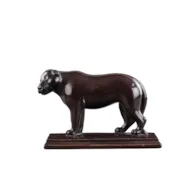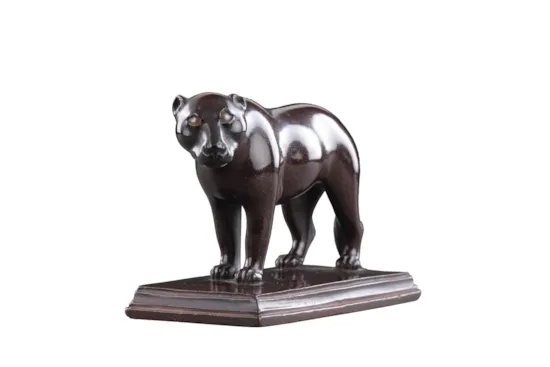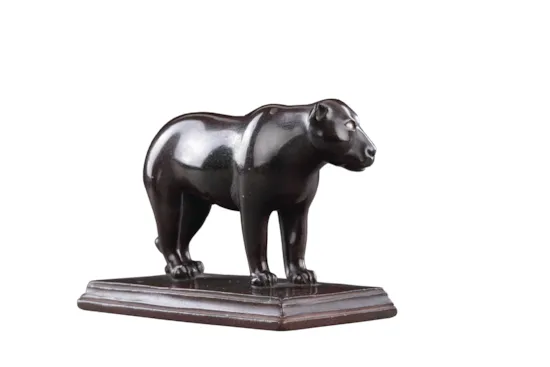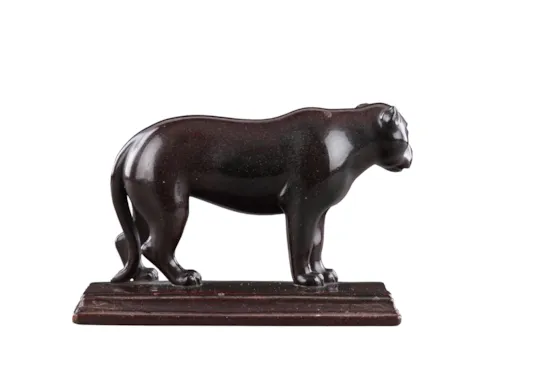A Rare ‘Grand Tour’ Model of a Striding Lion with Inlaid Eyes
A Rare ‘Grand Tour’ Model of a Striding Lion with Inlaid Eyes
Attributed to Antonio Moglia (active: 1765 - 1783)
Porphyritic type stone
Rome, Italy
Late 18th Century / Early 19th Century
SIZE: 7.5cm high, 11cm wide, 5cm deep - 3 ins high, 4⅓ ins wide, 2 ins deep
Attributed to Antonio Moglia (active: 1765 - 1783)
Porphyritic type stone
Rome, Italy
Late 18th Century / Early 19th Century
SIZE: 7.5cm high, 11cm wide, 5cm deep - 3 ins high, 4⅓ ins wide, 2 ins deep
A Rare ‘Grand Tour’ Model of a Striding Lion with Inlaid Eyes
Attributed to Antonio Moglia (active: 1765 - 1783)
Porphyritic type stone
Rome, Italy
Late 18th Century / Early 19th Century
SIZE: 7.5cm high, 11cm wide, 5cm deep - 3 ins high, 4⅓ ins wide, 2 ins deep
Attributed to Antonio Moglia (active: 1765 - 1783)
Porphyritic type stone
Rome, Italy
Late 18th Century / Early 19th Century
SIZE: 7.5cm high, 11cm wide, 5cm deep - 3 ins high, 4⅓ ins wide, 2 ins deep
Although little is known about the career of Antonio Moglia, one of the outstanding characteristics defining his attributed work is perhaps the naturalness with which he was able to give life to the feline subjects.
Moglia is known to have been active in Rome in the late 18th and early 19th century and was undoubtedly influenced by the acclaimed ‘Sala degli animali’ (Zoo of stone animals) at the Vatican. Established by Pope Clement XIV (1769 - 1174) the collection comprised antique animals carved in marble and polychrome hard stones. A favourite tourist destination for visitors in Rome during the Grand Tour period, Pope Pius VI (1775 - 1799) subsequently enlarged the rooms and commissioned sculptors of the time to add the animal collection with new creations in the ‘antique taste’. These include sculptors particularly specialising in the restoration of antiquities who included Bartolomeo Cavaceppi (1716 - 1799), Carlo Albacini (1739 - 1807) and
Francesco Antonio Franzoni (1734 - 1818).
It is Moglia, that is thought to have also worked on the animals in the collection and on the restoration of ancient marbles belonging to Ludwig I of Bavaria.
The tenderness and ‘alertness’ with which Moglia has captured within this sculpture knows no bounds, the feline is shown walking silently and yet alert, in readiness to ‘pounce’ or ‘sprint’ to capture its prey. The inlaid eyes are further enhanced with a slight ‘sparkle’. At first appearance the sculpture looks to have been made in one piece of marble, yet on close inspection, the feline and integral base are in turn ‘cut’ into a further marble rectangular plinth.
Made from a Porphyritic type stone, the ‘purple’ colour emphasises the ancient ‘imperial porphyry’ and its continued use of colour favoured by ‘Royalty’.
RELATED LITERATURE:
González-Palacios, Il seraglio di pietra. La sala degli animali in Vaticano, Rome, 2013
P. Liverani, G. Spinola, Vaticano, La Sala degli Animali nel Museo Pio-Clementino, Milan, 2003, p. 31, 117-118
G. Borghini, Marmi antichi, Rome, 1997, p. 216.
Moglia is known to have been active in Rome in the late 18th and early 19th century and was undoubtedly influenced by the acclaimed ‘Sala degli animali’ (Zoo of stone animals) at the Vatican. Established by Pope Clement XIV (1769 - 1174) the collection comprised antique animals carved in marble and polychrome hard stones. A favourite tourist destination for visitors in Rome during the Grand Tour period, Pope Pius VI (1775 - 1799) subsequently enlarged the rooms and commissioned sculptors of the time to add the animal collection with new creations in the ‘antique taste’. These include sculptors particularly specialising in the restoration of antiquities who included Bartolomeo Cavaceppi (1716 - 1799), Carlo Albacini (1739 - 1807) and
Francesco Antonio Franzoni (1734 - 1818).
It is Moglia, that is thought to have also worked on the animals in the collection and on the restoration of ancient marbles belonging to Ludwig I of Bavaria.
The tenderness and ‘alertness’ with which Moglia has captured within this sculpture knows no bounds, the feline is shown walking silently and yet alert, in readiness to ‘pounce’ or ‘sprint’ to capture its prey. The inlaid eyes are further enhanced with a slight ‘sparkle’. At first appearance the sculpture looks to have been made in one piece of marble, yet on close inspection, the feline and integral base are in turn ‘cut’ into a further marble rectangular plinth.
Made from a Porphyritic type stone, the ‘purple’ colour emphasises the ancient ‘imperial porphyry’ and its continued use of colour favoured by ‘Royalty’.
RELATED LITERATURE:
González-Palacios, Il seraglio di pietra. La sala degli animali in Vaticano, Rome, 2013
P. Liverani, G. Spinola, Vaticano, La Sala degli Animali nel Museo Pio-Clementino, Milan, 2003, p. 31, 117-118
G. Borghini, Marmi antichi, Rome, 1997, p. 216.
Ex Private North Country collection
A Rare ‘Grand Tour’ Model of a Striding Lion with Inlaid Eyes

SOLD






YOU MAY ALSO LIKE

